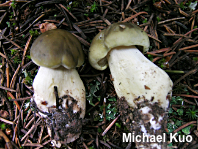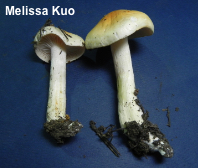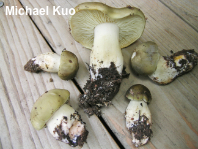| Major Groups > Gilled Mushrooms > Pale-Spored > Tricholoma > Tricholoma rapipes |

|
Tricholoma rapipes [ Basidiomycota > Agaricales > Tricholomataceae > Tricholoma . . . ] by Michael Kuo You're not going to find Tricholoma rapipes in your North American field guide, but I think there's a fair chance you will find it—or something very close to it—under spruce and fir trees in our continent's montane and sub-boreal forests. The species was recently validated (Christensen & Heilmann-Clausen 2013) in northern Europe as a distinct member of the Tricholoma saponaceum species group. Like other species in the group it features flesh that turns reddish to orangish in the base of the stem and a soap-like odor, but it can be separated on the basis of its spruce/fir association, its yellow to yellow-green colors, and its tapered and rooting stem base. To be clear, Christensen & Heilmann-Clausen do not document Tricholoma rapipes outside of Scandinavia and France. But the yellow to yellow-green "Tricholoma saponaceum" often collected in the spruce-fir forests of the Rocky Mountains is a plausible match, based on its physical features and ecology, and calling it Tricholoma rapipes makes more sense than throwing it together with potentially dozens of gray and brown versions of Tricholoma saponaceum from diverse ecosystems (see the discussion on the page for Tricholoma saponaceum). Description: Ecology: Mycorrhizal with spruces and firs, especially Engelmann spruce and subalpine fir; growing alone, scattered, or gregariously; late summer and early fall (monsoon season) in the Rocky Mountains; potentially in summer and fall in northern North America; in Scandinavia and the Alps appearing in late summer and fall. The illustrated and described collections are from Colorado. Cap: 3–8 cm across; at first conical-convex with an incurved margin, becoming broadly convex or nearly flat, often with a central bump; dry or tacky; bald; yellowish green to greenish yellow, with a pale yellow or nearly whitish margin. Gills: Attached to the stem by a notch; close or nearly distant; short-gills frequent; whitish; sometimes developing yellow shades with age. Stem: 3–6 cm long above ground; 1–2 cm thick; tapered to base, with a substantial rooting portion; bald or, near the apex, finely mealy; dry; whitish, with flushes of pale yellowish or pale yellowish green; staining pinkish orange to orangish brown, especially toward the base; basal mycelium white. Flesh: Whitish and unchanging when sliced, except in the stem base, where it is usually pinkish to orangish. Odor and Taste: Soap-like or not distinctive. Chemical Reactions: KOH pale orange on cap surface. Spore Print: White. Microscopic Features: Spores 5–7 x 3.5–5 µm; ellipsoid; smooth; hyaline in KOH; inamyloid. Lamellar trama parallel. Basidia 4-sterigmate. Hymenial cystidia not found. Pileipellis a cutis; elements 5–10 µm wide, smooth, hyaline in KOH. Clamp connections present. REFERENCES: (Krombholz, 1836) Heilmann-Clausen & Christensen, 2013. (Heilmann-Clausen et al., 2017; as "T. saponaceum:" Smith, 1975; States, 1990; Evenson, 2015; Cripps, Evenson & Kuo, 2016.) Herb. Kuo 08060503. Herb. DBG RMNP 2008-040; 2009-021; 2012 5022-09. This site contains no information about the edibility or toxicity of mushrooms. |
© MushroomExpert.Com |
|
Cite this page as: Kuo, M. (2019, September). Tricholoma rapipes. Retrieved from the MushroomExpert.Com Web site: http://www.mushroomexpert.com/tricholoma_rapipes.html |



